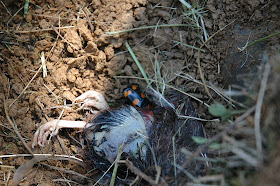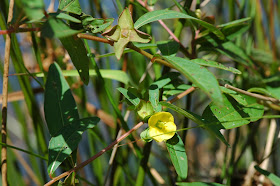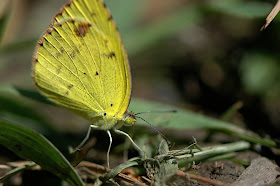Friday, August 27, 2010
Keep Your Hands Off My Dodder!
Here I am sitting quietly at Wakeena minding my own business. Trying to be as still as possible and photograph these, when who sneaks but behind me but manager Tom Shistler, and yells those very words. Needless to say I flinched.
Who sprayed Silly String all over my garden?? Dodder is a common parasitic, non-chlorophyl plant. In much the same way butterflies can detect chemicals from a plant most suitable for it's caterpillars, Dodder also senses which plants are emitting the most volatile chemicals, and grows towards that potential host.
Looking like bright copper wiring, Dodder begins to wrap around a plant. It does not hold so tightly as to choke the plant though.
Consisting of clusters of small white 5-petaled flowers, Dodder begins to literally "drill" down into the stem of it's host.
Once establishing it's "roots" inside a new plant, it severs itself from the original growth coming from the ground. From this point on it is dependent on it's host for all nutrients.
Dodder was once in a family all it's own, but is currently placed as a member of the Morning Glory family. I say currently because plant families seem to change like the moon these days, so who knows where it will eventually stay.
Since it has no need to photosynthesize, it has no green leaves. The leaves have been reduced to scale like bumps along the stem.
There are 15 species of Dodder in the eastern U.S. All of them look alike. As to which species are pictured here? I have no idea, go ask your dodder.
Wednesday, August 25, 2010
The American Burying Beetle Project
In a previous post I made mention of carrion beetles, and thought hey, why not share some info about a project I was involved with.
The American Burying Beetle Nicrophorus americanus, is a federally endangered species. Populations occur today just west of the Mississippi River and in portions of Massachusetts. The historic range included all the states in between. No one knows exactly why their populations have dwindled so rapidly. Our land use practices probably play a part. One of the more accepted theories has to do with the extinction of the Passenger Pigeon.
American Burying Beetles were common in collections until the birds demise. The simple lack of available carrion may be to blame. In the last decade, there has been an effort to reintroduce them throughout their previous range. Here in Ohio, the U.S. Forest Service is working with the Fish & Wildlife Service. Beetles are being raised at the St. Louis Zoo and Ohio State University.
When a site is located, beetles are transported in plastic containers holding either a male or female.
Male and females are all laid out and paired up.
Then a series of holes are dug just deep enough to put the food source in.
The beetles are not spread out through the forest, but released in a concentrated area.
Dead birds such as quail or young chickens are used to attract the beetles and encourage them to begin mating and preparing the food source. These beetles emit a chemical upon the carrion that discourages the growth of bacteria.
The beetles are then removed from their containers and dropped into the holes. There are other species of carrion beetles in Ohio that have 4 orange spots on the wings, but the spots are much smaller. The American Burying Beetle also shows a very large orange spot on the thorax, and yet another spot on the head. This species is also larger than all the others in the family.
While it is inevitable that some beetles will wander away from the holes, most immediately take to being put on a dead carcass. After both sexes have been put in the ground, dirt is put back over the area.
A screen is then laid over all the released beetles. Of course they can crawl out of the screen. The hope is they will stay put and begin to raise young.
The screen is then secured tightly to the ground with a series of nails. This is to prevent other predators from digging up the dead birds. After the young are born, the adults tear pieces of meat off and feed it to the young. In the same way gulls tap the beak of their parents to be fed, the young beetles will often nip at the mandibles of their parents when hungry. These beetles can live for a year, and it is with hope that projects like this will bring the populations back.
The American Burying Beetle Nicrophorus americanus, is a federally endangered species. Populations occur today just west of the Mississippi River and in portions of Massachusetts. The historic range included all the states in between. No one knows exactly why their populations have dwindled so rapidly. Our land use practices probably play a part. One of the more accepted theories has to do with the extinction of the Passenger Pigeon.
American Burying Beetles were common in collections until the birds demise. The simple lack of available carrion may be to blame. In the last decade, there has been an effort to reintroduce them throughout their previous range. Here in Ohio, the U.S. Forest Service is working with the Fish & Wildlife Service. Beetles are being raised at the St. Louis Zoo and Ohio State University.
When a site is located, beetles are transported in plastic containers holding either a male or female.
Male and females are all laid out and paired up.
Then a series of holes are dug just deep enough to put the food source in.
The beetles are not spread out through the forest, but released in a concentrated area.
Dead birds such as quail or young chickens are used to attract the beetles and encourage them to begin mating and preparing the food source. These beetles emit a chemical upon the carrion that discourages the growth of bacteria.
The beetles are then removed from their containers and dropped into the holes. There are other species of carrion beetles in Ohio that have 4 orange spots on the wings, but the spots are much smaller. The American Burying Beetle also shows a very large orange spot on the thorax, and yet another spot on the head. This species is also larger than all the others in the family.
While it is inevitable that some beetles will wander away from the holes, most immediately take to being put on a dead carcass. After both sexes have been put in the ground, dirt is put back over the area.
A screen is then laid over all the released beetles. Of course they can crawl out of the screen. The hope is they will stay put and begin to raise young.
The screen is then secured tightly to the ground with a series of nails. This is to prevent other predators from digging up the dead birds. After the young are born, the adults tear pieces of meat off and feed it to the young. In the same way gulls tap the beak of their parents to be fed, the young beetles will often nip at the mandibles of their parents when hungry. These beetles can live for a year, and it is with hope that projects like this will bring the populations back.
Tuesday, August 24, 2010
You mite be right about that
Have you ever noticed little red dots scattered around on the bodies of various arthropods? These are 8-legged mites (Arachnids). Most do no harm to their "taxi driver", they are just hitch-hiking a ride from place to place. Yet there are some mites that are true parasites.
Let's take the whole family for a Sunday cruise. Harvestmen (Daddy-Longlegs) are voracious predators, and the mites probably don't mind the scraps. But there is one genus, Leptus, whose larvae do parasitize Harvestmen on their femurs, and that 'might' be what's happening here.
"Hey where'd everybody go?" This loner grabbed a ride on the head of a Scorpionfly (Mecoptera). Thanks to Lisa Sells (Zen Through A Lens) for the use of this picture.
"I'm in the mood for Possum Pate". Well you just might get your wish. Carrion beetles, also known as Burying Beetles, are well known as the vultures of the insect world. They tear apart road kill and make it available to the young beetles. A rare example of parental care in insects.
The beetles provide the transportation to the carrion. The mites prey upon fly pupa and maggots, thus reducing the competition for the beetles. Mutualism at it's best. One mite species does the same to honeybees, and a few years ago may have been responsible for as much as one-third of the honeybee population crashing.
Let's take the whole family for a Sunday cruise. Harvestmen (Daddy-Longlegs) are voracious predators, and the mites probably don't mind the scraps. But there is one genus, Leptus, whose larvae do parasitize Harvestmen on their femurs, and that 'might' be what's happening here.
"Hey where'd everybody go?" This loner grabbed a ride on the head of a Scorpionfly (Mecoptera). Thanks to Lisa Sells (Zen Through A Lens) for the use of this picture.
"I'm in the mood for Possum Pate". Well you just might get your wish. Carrion beetles, also known as Burying Beetles, are well known as the vultures of the insect world. They tear apart road kill and make it available to the young beetles. A rare example of parental care in insects.
The beetles provide the transportation to the carrion. The mites prey upon fly pupa and maggots, thus reducing the competition for the beetles. Mutualism at it's best. One mite species does the same to honeybees, and a few years ago may have been responsible for as much as one-third of the honeybee population crashing.
While Walking Wakeena Wetlands, silly wabbit
You need to visit Wakeena Nature Preserve down here in the heart of the Hocking Hills. It is one of the last areas still being staffed by the Ohio Historical Society. The plant diversity is incredible. If you're a fern lover, there are nearly 30 species here.
It's late August, and I was curious to see what was blooming along the floating boardwalk. Catching your eye immediately is the Fragrant or Sweet-scented Water-lily, and the Swamp Rose Mallow.
Both the orange and yellow Jewelweed (Touch-Me-Not) are common here.
Most people are familiar with the showy Flowering Dogwood tree. But there are a half dozen other native dogwoods, all shrubs. Other than subtle differences in the leaves and twigs, often fruit is needed to be sure of which you have. This is Silky Dogwood (Cornus amomum). A wetland species whose fruit turns from white to a shiny purple-blue.
A member of the evening primrose family, Seedbox, with it's 4 petals and unique seed case are distinct.
Two VERY showy species found in moist to wet soils are the Cardinal Flower and Great Lobelia
Speaking of which, I noticed this little guy which I thought was also a Lobelia at first. Laying prone on my stomach and holding on to the back of the boardwalk with my feet, I stretched over the pond to reach this guy. Hey it's only water, what can happen. Oh ya, there is the camera thing. Turns out this is False Pimpernel.
Obiedient Plant is abundant here. Named for the fact you can turn the flowers in any direction, and they stay where you point them. I tend to do this a lot since I'm mischievous anyway.
While maybe not as showy as others, the Arrow-leaved Tear-thumb is a common wetland inhabitant. Upon examination of the stem, you'll see where the name comes from.

Sunday, August 22, 2010
Butterflies
Being this is my first contribution, I realize I may cover material posted at other sites. I have found that there are over 1,200 other nature blogs, and there is no way I can follow them all. So welcome to my world.
What better way to start a site than with butterflies. People like them, they are showy, and easy to observe during the day. On the other hand, I, being a moth man.....
Nymphalidae, or the Brush-footed butterflies are probably the most diverse family and the easiest to recognize. Since we are in the buckeye state, let's start with a Buckeye butterfly.
Great Spangled Fritillary
The intricate beauty is on the backside of the Painted Ladies. They are similar on the inside. The Painted Lady shows 4 small circles on the hindwing. The American Painted Lady, pictured here, has two large spots on the hindwing.
Red-spotted Purple. Notice the absence of tails. This should prevent you from thinking it's a swallowtail.
This guy had just fallen in the water and was a bit befuddled. It sat patiently while gathering it's surroundings. The dot and dash in the hindwing make this a Question Mark. Remove the dot, and you have a Comma butterfly. These butterflies will commonly light on your neck or headband looking to feed on the salt in your sweat.
The Viceroy. We've all probably heard the classic story of how this resembles a Monarch. Because Monarchs feed on Milkweed, birds and other predators become sick when eating them. So when they see this, they "think" it's a Monarch, and leave it alone. What you may not know is that in the south a Monarch relative called the Queen is more common and much darker orange than this. In the south, the Viceroys are also much darker. Coincidence? I think not. Mimicry in action.
So how do you separate them? Viceroys have 1-2 rows of dots on the wing edge, Monarchs 2-3. More reliable are the white spots in the forewings. They are orange-yellow in Monarchs. See the black stripe crossing the veins in the hindwing? This is absent on Monarchs.
Lycaenidae, the Blues and Coppers. Here this American Copper seems lost in the sand. Butterflies like loose sand and wet dirt because it's easy to probe for essential minerals.
The Blues get their name from the inside portion of their wings.
This is an Eastern Tailed Blue sitting on Bush Clover.
The Spring and Summer Azure are very similar both inside and out, but lack the tails.
Some blues are heavily patterned on the back, such as this pair of Cassius Blues from Florida.
Here's the male hovering over the female while mating.
Also in this family are the Hairstreaks. These are rapid and erratic fliers. Only when they land can you get a good look at them. They always sit with their wings closed. One of the most common species in Ohio is the Red-banded Hairstreak.
A rather uncommon species in Ohio is the White-M Hairstreak. They tend to stay in forest trees and only come out to the edges. As you can see this one is a bit ragged and torn up. It was having trouble flying and wasn't paying any attention to me. The wings on the inside are the most brilliant iridescent blue you can imagine. Reminds me of the Morpho butterflies of the tropics. I was happy to see this guy in the Zaleski forest.
Another common species in Ohio is the Gray Hairstreak. Compare the two pictures. Notice the longer set of tails straight, then crossed in the second picture. When hairstreaks land they rub their hindwings up and down making the tails appear like antennae. Couple that with what look like two little black eyes, a predator thinks it's attacking the head region, thus allowing the butterfly to fly forward and escape.
Pieridae, the Sulphurs. Everyone is familiar with our three most common members. The yellow Clouded Sulphur, the orange Alfalfa, and the white Cabbage Butterfly. Often overlooked is this little one, and yes it's called the Little Sulphur. I never used to see these around, but they have been popping up frequently in the past week. I found a couple of them puddling at a mud hole at Lake Hope. You can recognize it by the small size and that orange spot on the hindwing.
Papilionidae; the Swallowtails. Oh I could put up pretty pictures of them all, but I'll limit it to one for now. The Tiger Swallowtail, usually bright yellow and black, often shows a dark form in some females. Even though it's all black, you can look through the wings and see the hidden stripes.




















































